
The U.S. plastics industry: a 2022 recap
By Perc Pineda, PhD, chief economist, Plastics Industry Association
Economy Moldmaking Plastics ProcessesThe U.S. plastics industry continued to grow in 2022 against the backdrop of weaker domestic and global economic growth.
The U.S. plastics industry continued to grow in 2022 against the backdrop of weaker domestic and global economic growth. Data shows that the U.S. economy’s output contracted in the first half of 2022 and followed by what appears to be a tepid output growth rate in the second half of 2022. The manufacturing sector—plastics industry included—continued to adjust to domestic and global economies that have started to downshift into a lower gear this year. Seven charts explain how the U.S. plastics industry, throughout the supply chain, performed in 2022. This includes PLASTICS’ projections of end-of-year monthly data that has not been released at the time of writing this article. All told, demand for plastics and plastic products stayed stable in 2022.
1. Industrial Production of Plastic Products Manufacturing
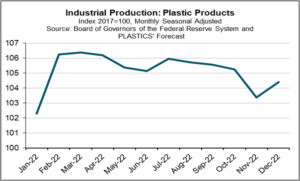
Plastics production increased the most in February based on the Industrial Production Index on plastic products manufacturing. It increased 3.9% in February from January—a 5.7% increase from February of last year. However, production slowed thereafter, falling to 1.8% in November. Weaker plastics production is consistent with lower economic growth. The U.S. economy had two consecutive quarters of negative output growth in the first half of 2022. Persistent high inflation rates, rising interest rates, and lower disposable income caused a pullback on consumer spending, particularly on interest-rate-sensitive goods. Given that a significant portion of plastics production ends up in nondurable goods consumption, which remains stable regardless of where the economy is in the business cycle, it can be expected that plastics production could increase by as much as 1.0% in December, which is equivalent to a 1.5% increase from December 2021.
2. Plastics and Rubber Shipments
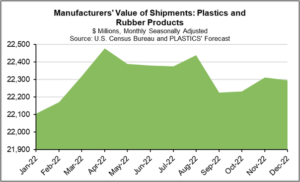
The monthly shipments of plastics and rubber fluctuated this year between $22.1 billion and $22.5 billion. It peaked in April and decreased thereafter. Based on the latest data from the U.S. Census Bureau, shipments were virtually unchanged in October from the month prior. Healthy demand for manufactured goods, against the backdrop of lingering supply chain issues, caused manufacturers’ inventories to sales ratio to decrease to 1.45 in October form 1.50 a year earlier. To replenish inventory, shipments of plastics and rubber most likely increased by an estimated 0.4% in November. Although shipments likely decreased marginally by 0.1% in December, at this rate, 2022 closed with plastics and rubber shipments higher by 2.0% compared to December of last year.
3. Plastics Manufacturing Employment
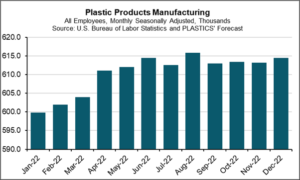
The economy’s labor participation rate improved somewhat from 61.7% rate in 2021 to 62.2% in 2022. Still, the U.S. plastics industry continued to experience labor supply constraints in 2022. Some open positions remain unfilled this year. Hiring in plastic products manufacturing rose steadily in the first half of 2022 to 614.4 thousand as estimated by the U.S. Bureau of Labor Statistics but slowed in the second half of 2022. It is unlikely that hiring increased significantly in November, with the plastics and rubber manufacturing unemployment rate up 3.1% in November from 2.0% in October. It can be expected that plastics manufacturing employment will be virtually unchanged in November (613.2 thousand) from October (613.4 thousand) and could see a 0.2% uptick in December to 614.5 thousand.
4. Molds for Plastics Trade
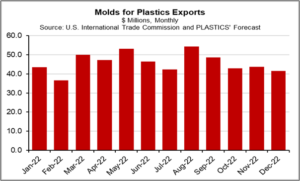
The exports of molds for plastics fluctuated monthly between $36.7 million in February to $54.3 million in August. Exports are usually the lowest during the summer months, however, exports of molds for plastics peaked in August before they decreased in the two months that followed. It is estimated that exports in November and December could top $43.7 million and $41.5 million, respectively. All told, exports of molds could average $45.8 million monthly in 2022, which will be higher than $44.5 million last year. While export orders may have increased, lingering supply chain issues have caused longer production lead-time causing export shipments to slow. Moreover, a strengthening U.S. dollar this year through November affected U.S. export growth.
5. Producer Prices in Plastics Material and Resin Manufacturing
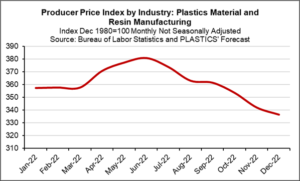
Plastics material and resin prices peaked in June this year based on the Producer Price Index on plastics material and resin manufacturing from the U.S. Bureau of Labor Statistics. It continued to fall since as supply eventually caught up with rising demand. Plastics converters enjoyed a respite from the double-digit increase in resin prices in 2021. It is projected that the price index could decrease by 1.6% in December—an 8.6% decrease from December 2021. With rising capacity and softening demand, it can be expected that the monthly percentage change in the Producer Price Index on plastics material and resin manufacturing will be less volatile.
6. Industrial Capacity in Plastics Material and Resin Manufacturing
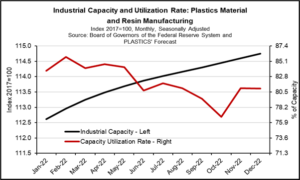
The industrial capacity in plastics materials and resin manufacturing in the U.S. has been increasing this year. However, capacity is expected to have increased by 1.9% in 2022—lower than the 7.1% capacity increase in 2021. Lower growth rates in industrial capacity this year, against the backdrop of falling resin prices, suggest that there is sufficient plastics material and resin supply. This could explain the decrease in the capacity utilization rate in plastics material and resin manufacturing from February to October. The capacity utilization rate could increase to 81.0% in November and December 2022 to cover lower inventories. Latest data from the U.S. Census Bureau shows manufacturers finished goods inventories in plastics and rubber products decreased in the last three months ending in October. Any improvements in inventories would most likely be minimal in November and December.
7. Plastics Machinery Imports
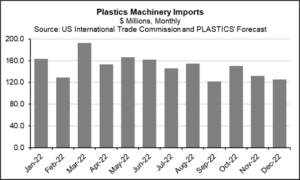
It is expected that imports of U.S. plastics machinery in 2022 will be less than in 2021. The latest data from the U.S. International Trade Commission show that imports increased in October by 0.2% from September. Since March, however, the underlying trend in U.S. plastics machinery imports has been downward sloping. If this trend continues, 2022 imports could average $150.3 million per month, which would be 51.5% lower than last year’s monthly average. Demand for plastics machinery has softened in 2022—a reversal from the robust demand in 2021. The value of U.S. plastics machinery imports could total $1.8 billion in 2022—well below the $3.5 billion last year. Higher interest rates have slowed capital expenditures—particularly on industrial equipment investment spending. Even with a strong U.S. dollar in recent months, which is a boon for imports, the slowdown in plastic products manufacturing, against the backdrop of a weaker macroeconomic outlook, negates the demand for higher imports of equipment.
